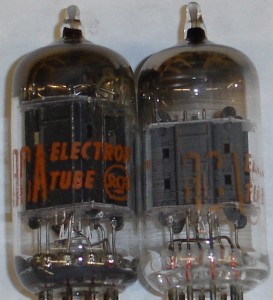There is a lot of discussion about Black vs Gray plates tubes. Some people believe that claim that black plates sound better is just a myth created by tube vendors to increase prices, some people swear by black plates in their systems.
So what’s true and what’s not.
First of all, black plates are not magical – there are superb gray plates tubes that sound as good and better than black plates tubes, so it’s definitely not about the color. However, black color does help if all else is equal. I will try to explain it here as simply as I can.
In the process of tube emitting electrons from the cathode, they fly at a very high speed towards the anode (a plate that what you can see in a tube easily – big metal piece and the outer shell). Because of the speed, electrons hit the anode with high kinetic energy and thus produce heat, also remember that cathode is heated to 800-1000 F, which increases internal temperature. Black materials radiate heat easier, thus reducing plate temperature faster. The hotter the anode, the worst it is for performance because – Hot anode causes:
1) release of gas from anode metal outgassing, and thus contaminating vacuum.
2) heat up of control grid causing grid emissions, and thus increasing noise or even causing cathode stripping, which in turn increases grid emissions.
So in these cases, black is better.
Now, the benefits don’t stop there. There are smooth black plates like in Sylvania & Raytheon preamp tubes, and then there are carbonized black plates in Ken-Rad, Westinghouse and RCA. Carbonization of plates (making them look black) reduces secondary emissions, which creates an electric field between cathode and anode and causes distortions. This is one of the most important factors in black plate tubes. Carbon creates a rough surface on the top of nickel plate and thus reduces secondary emissions by recapturing electrons (ping me for more info on that J)
So all in all, black plates can have very real benefits on tube performance and thus are not just a BS.
To combat the 3 problems, there are other techniques that are used.
For Grid emissions, tubes like 6P45P and 6P14P-EV have grid plated with gold with a mixture of platinum, which has very low relative emission. Some tubes used fins on grid rods to help with the reduction of grid temperature.
For secondary emissions, some power tubes like 7236 & 6080 have carbon plates, zirconium coated plates and graphite plates. This is also not a gimmick but the real thing with real benefit in dynamics and transparency.
And to reduce anode temperature woven wire mesh plates have been used. Also, tube shields should be avoided as much as possible, since they increase anode temperature by reflecting heat back into the tube. Also, stay away from chrome transformers that are located close to tubes, they reflect heat back. Black transformers are the way to go.


From my experience, black plate tubes usually sound more open and detailed with a huge soundstage. Grey ones usually have deeper bass response with a warmer presentation.